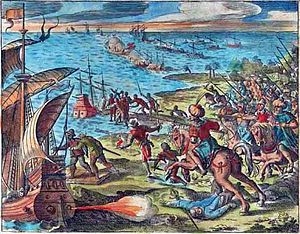| Second siege of Diu[a] | |||||||
|---|---|---|---|---|---|---|---|
| Part of Ottoman–Portuguese conflicts (1538–1560) and Gujarati–Portuguese conflicts | |||||||
 A battle between the Portuguese Armada and Turkish soldiers on horseback in Goa, western India | |||||||
| |||||||
| Belligerents | |||||||
| Portuguese Empire | |||||||
| Commanders and leaders | |||||||
| Khoja Zufar † | ||||||
| Strength | |||||||
| Casualties and losses | |||||||
| More than 200[3] |
| ||||||
Location of Diu in present-day India | |||||||
The 1546 siege of Diu, also known as the second siege of Diu[a] was a siege of the Portuguese Indian city of Diu by the Ottoman Empire and Gujarat Sultanate. It ended with a major Portuguese victory.
Background
editAt the beginning of the 16th century, the Muslim Sultanate of Gujarat was the principal seapower in India. Gujarat fought the Portuguese fleets in collaboration with the Mamluk Sultanate. The Portuguese were defeated by a combined Mamluk-Gujarati fleet in 1508, which was in turn destroyed by a Portuguese fleet in the Battle of Diu (1509).
The Portuguese again attempted to capture the city in 1531. While the Ottoman-Gujarati defenders successfully withstood the siege, victory was short-lived. In 1535 Sultan Bahadur of Gujarat concluded a peace treaty with the Portuguese, allowing them to build a fort at Diu. By 1536, the Portuguese had gained complete control of Diu, while the Sultanate of Gujarat was under attack from the Mughals.[6]
In 1538, the Ottoman Empire, which had taken over Egypt (1517) and Aden (1538) from Mamluk Egypt, joined hands with the Gujarat Sultanate to launch an anti-Portuguese offensive. They besieged Diu in 1538, but had to retreat.
The siege
editAfter the failed first siege of 1538, the Gujarati General Khadjar Safar besieged Diu again in an attempt to recapture the island. The siege lasted seven months from 20 April 1546 to 10 November 1546, during which João de Mascarenhas defended Diu.[7]
A large fleet dispatched by Suleiman would also arrive in Diu and help in the struggle against the Portuguese defenders. [1][5]
The siege ended when a Portuguese fleet under Governor João de Castro arrived and routed the attackers.[7]
Khadjar Safar and his son Muharram Rumi Khan (who were probably of Albanian origin[citation needed][relevant?]) were both killed during the siege.[8]
See also
edit- Siege of Diu (1538) – The "first siege", so called as the first successful Portuguese defence of Diu against a Gujarati-Ottoman attempt to recapture Diu
- Siege of Diu (1531) – The earlier siege in which Gujarati and Ottoman forces succeeded in defending the city against Portuguese besiegers
- Catarina Lopes
- Isabel Madeira
Notes
edit- ^ a b Two earlier sieges of Diu occurred. The 1546 siege is traditionally referred to as the second, not third, siege of Diu: this follows the terminology of early historiography that counts only the two successful Portuguese defences of Diu in assigning ordinal titles to the sieges. The 1538 siege is known as the "first". The siege prior to 1538 – in 1531 – was conducted by the Portuguese against Gujarati-Ottoman defenders, who withstood the attack.[9][10]
References
edit- ^ a b Malekandathil, Pius (2010). Maritime India: Trade, Religion and Polity in the Indian Ocean. Primus Books. p. 116. ISBN 978-93-80607-01-6.
- ^ Casale, Giancarlo (25 February 2010). The Ottoman Age of Exploration. Oxford University Press. ISBN 978-0-19-970338-8.
- ^ a b c d Mathew, K. M. (1988). History of the Portuguese navigation in India, 1497-1600. Delhi: Mittal Publications. pp. 218–219. ISBN 8170990467.
- ^ a b John Holland Rose; Ernest Alfred Benians; Arthur Percival Newton (1960). The Cambridge History of the British Empire, pp. 16–17
- ^ a b Clodfelter, Micheal (24 April 2017). Warfare and Armed Conflicts: A Statistical Encyclopedia of Casualty and Other Figures, 1492–2015 (4th ed.). McFarland. ISBN 978-1-4766-2585-0.
- ^ Danvers, Frederick Charles (1894). The Portuguese in India: A.D. 1481–1571. W.H. Allen & Company. pp. 402–428.
- ^ a b Tony Jaques, ed. (2007). Dictionary of Battles and Sieges: A Guide to 8,500 Battles from Antiquity Through the Twenty-first Century. Vol. 1 (A–E). Greenwood. p. 304. ISBN 978-0-313-33537-2.
- ^ Kenneth Warren Chase (2003). Firearms: a global history to 1700 (illustrated ed.). Cambridge University Press. p. 136. ISBN 978-0-521-82274-9.
- ^ Couto, Dejanirah (2014). "Rûmî Networks in India: A Snapshot on the Second Siege of Diu (1546)". In Dejanirah Couto; Feza Günergun; Maria Pia Pedani Fabris (eds.). Seapower, Technology and Trade: Studies in Turkish Maritime History. Istanbul: Piri Reis University Publications, Denizler kitabevi. pp. 103–114. ISBN 9789944264518. OCLC 889889401.
- ^ Antunes, Luís Frederico (2009). "Diu". In Alexandra Pelúcia (ed.). Enciclopédia Virtual da Expansão Portuguesa (Séculos XV–XVIII) [Encyclopaedia of Portuguese Expansion (15th–18th centuries)] (in English and Portuguese). Lisbon: CHAM. ISBN 978-989-8492-38-8.
